1 August, 2019 | Match & Coarse | Tips | Articles
166 CommentsBarbel Fishing On The Tidal River Trent – Tony Gibson
The River Trent has become the go-to destination for big barbel fishing. Tony Gibson heads out on to the bank and gives his tips on tackling the mighty waterway..
Tony continues…
With all the media attention and reports over the last few years of the barbel being caught from the Trent, especially the lower, tidal reaches below Cromwell Weir, it was inevitable that I’d end-up barbel fishing on “the tidal” at some stage.
I’m not a fan of barbel fishing during the warm summer months, preferring to fish for them later in the year when they tend to weigh a little heavier and be at their peak condition. However, the opportunity of an overnight session to try out the full range of Dynamite Bait’s new addition to the Big Fish River range, the “Meat-Furter”, ahead of my usual barbel and chub fishing later in autumn and winter months was an opportunity not to be missed.
The session..
It was still raining heavily when I arrived at the river early afternoon (and continued to do so frequently for the next few hours), but as I was walking the stretch, trying to decide where to start, I saw a guy suddenly grab a rod as a barbel took off with one of his hookbait.
Unfortunately, the fight was short lived, as the barbel fell off the hook half-way in, but it did help to indicate that there were a few fish in the area. This had also happened to be in one of the areas that the bailiff had indicated was a potential section to head for, so I elected to set up a few pegs upstream.
Two rods are allowed here and most people that barbel fish the Trent would probably make use of a two-rod set-up. It makes sense, with such a large, wide river, as it allows you to explore a bit more of the river itself and to also experiment with baits and presentation to see what the fish might prefer.
My rods for the trip were what would likely be classed as medium, through-action carp rods. They are Carp Spirit Magnum rods, with a 2.75lb test curve and my medium sized “big pit” style reels were loaded with a modern 15lb mono that is relatively thin for the stated breaking strain.
Go heavy or go home…
This may seem like overly heavy gear for barbel fishing, but the nature of the river and the weight of the feeders and leads required to effectively fish in the conditions presented mean that heavier gear is sometimes needed… and it’s always better to go ‘over gunned’ than to discover yourself compromised with too light a set-up and not able to fish properly or safely from a fishes welfare perspective.
My starting point was a heavy 4oz feeder on the upstream rod. This may seem like a heavy feeder to anglers used to fishing smaller, more intimate rivers, with less flow. However, the Trent in the lower reaches is a big river and with plenty of water pushing through, a lighter feeder simply wouldn’t hold bottom properly in the powerful current.
Effective feeder fishing requires the feeder to dispense the feed (and attraction from it) in the same consistent spot, rather than the feed being washed out of the feeder all over the place as the feeder is dragged about along the bottom if it isn’t heavy enough. Also, in the area I was fishing, there was no real opportunity to fish the slower paced flow right in the edge, as the side of the river was reinforced with large rocks and boulders that would quickly snag up a lead or feeder that was presented near the bank.
The setup…
I attached my feeder to the type of plastic run ring that allows a quick change of feeders/leads, with the run ring itself able to be fished either semi-fixed or completely free-running by utilising one of the specially designed rubber swivel protection beads with a groove where the run ring sits when used in semi-fixed mode.
This was fished with a long 3 to 4ft hooklength constructed from 15lb Carp Spirit Kameleon coated braid, with the coating stripped off on the bottom third of the rig. A strong Razor size 8 hook, tied knotless knot style, completes the rig, with a hair long enough to present a hair-rigged boilie or pellet with a few mm between the hook and the bottom of the hookbait.
A long hooklength helps to fool any wary barbel that might be attracted to the flow of feed from the feeder but might be cautious of getting too close to the feeder itself.
The downstream rod was set up similarly, but with a 4oz flat-pear shaped lead rather than a feeder. Again, a long 3 to 4ft hooklength; but for this rod I opted to tie up a lighter mono hooklink to see if a slightly less conspicuous hooklength might make a difference. Following the theme of a less conspicuous end-rig, I tied this hooklength up with a smaller sized 12 hook and aimed to fish slightly smaller baits on this rod.
One up, one down…
The idea of using the feeder on the upstream rod, with the straight lead on the downstream rod was to hopefully introduce the bulk of the feed and attraction via the swimfeeder on the upstream rod, but with a slightly more less obvious set-up fishing downstream of it to try and fool the barbel that might be attracted upstream to the scents and smaller particles of feed being washed downstream, but weary of approaching the potentially dangerous area immediately adjacent to the source of the attraction.
In ideal conditions, when large groups of barbel were well on the feed and showing no fear of approaching the swimfeeder, switching to feeders on both rods and introducing more feed to keep the fish interested and hopefully hold them in the swim, would probably be a better option. However, on this occasion, reports were that the barbel fishing had been “moody”, so I felt a more conservative approach to start with was probably best.
My bait…
With the full range of “Meat-Furter” goodies to play with, I decided to knock up a pungent groundbait mix to use in the swimfeeder, using the “Meat-Furter” groundbait wetted with roughly a 50/50 mix of river water and the “Meat-Furter” bait soak liquid.
I used the groundbait as plugs at either end of the swimfeeder, with a good helping of the “Meat-Furter” mixed sized pellets sandwiched in the middle of the feeder by the groundbait plugs. When using swimfeeders in such a deep, powerful river such as the tidal Trent, it’s important that the feed stays inside the feeder until it has reached and settled on the bottom. Therefore, the groundbait can be mixed quite stodgy and squeezed hard into both ends of the feeder prior to the cast.
Hookbait on the feeder rod was either the boilie style “Buster” hookbait, or the “Durable Hookers” in the “Meat-furter” flavour. For the downstream lead rod I experimented with a smaller hookbait in an attempt to fool more cautious fish that may be shying off the main feed and/or a larger hookbait, so here I used one of the “Durable Hookers”, but trimmed down a little with a pair of sharp scissors to make it smaller, or one of the “Buster” hookbaits, with about a third of one end cut away before mounting on the hair.
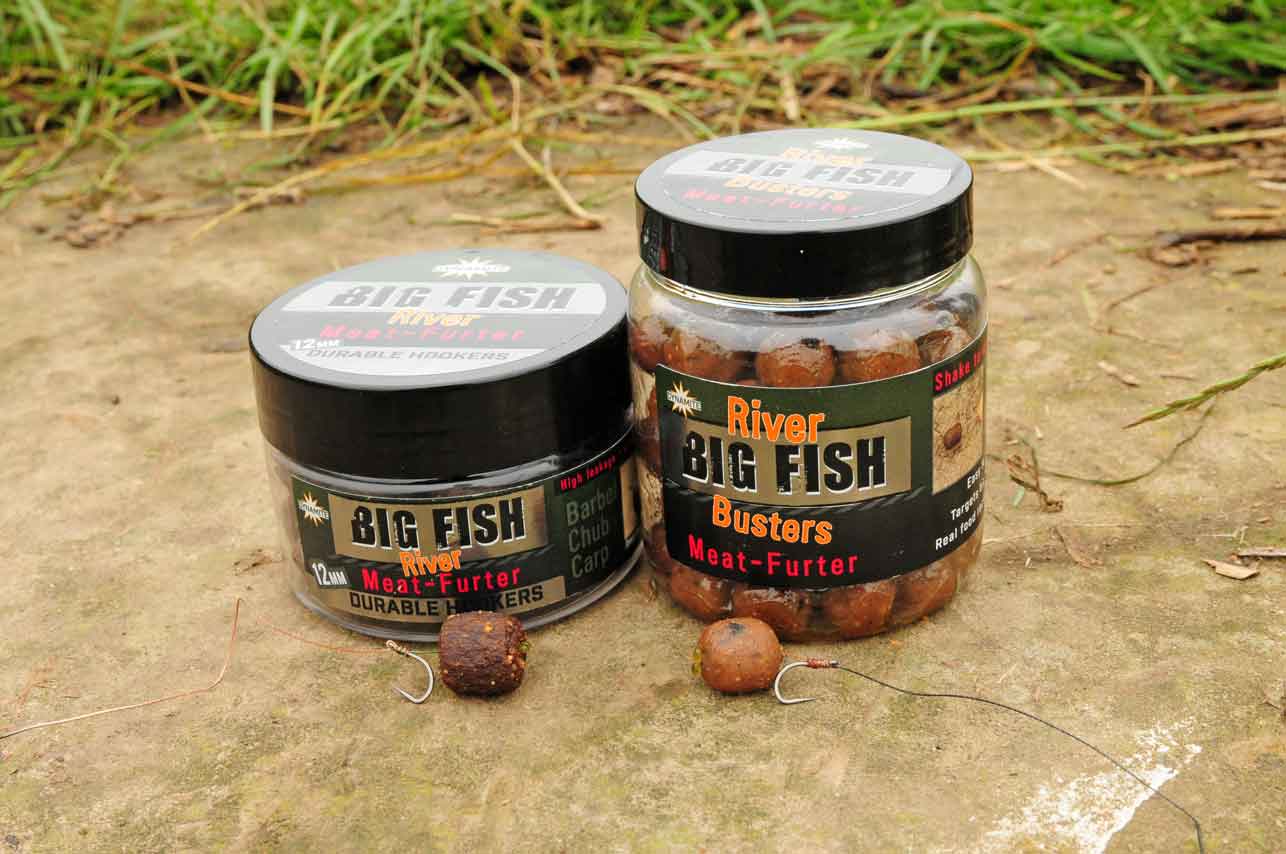
Both hookbaits can be trimmed for the downstream rod and left as they are for the upstream ‘more positive’ rod
To add a little extra attraction near the hookbait on this rod I squeezed some of the matching paste around the top of the lead and tied up some small PVA mesh bags of pellets to simply nick onto the hook for each cast.
Getting the rods angled right…
Both rods were set up using long banksticks with bite alarms at the front, to help keep the rod tips pointed well up in the air. This meant that there was less mainline going through the water and therefore less pressure on the line making it easier to hold either the feeder or lead in position.
The alarms would help to signal a bite if I wasn’t paying close attention, but the early stages of most bites were initially signalled by knocks and rattles on the rod tips before something more positive occurred and the alarms sounded. To help bite detection during the dark hours of the session I also fitted isotopes to the rod tips that I could see once the light had disappeared.
Once I was ready to cast out, the swimfeeder rod was lobbed out upstream, between approximately a quarter and a third of the way out, with the lead rod cast out at approximately the same distance, but 5 or 6 yards further downstream. Trying to fish closer in meant that there was a danger of the end tackle ending snagged in the rocks, while trying to fish further out would have required heavier leads and feeders to effectively hold bottom in the flow.
Keep casting…
The first few hours of the session were quite slow, with only a couple of bream succumbing to the downstream lead rod and the smaller hookbait. Both rods were regularly recast though, rather than just left to fish for themselves. It’s important to try and keep a regular supply of fresh feed going into the swim to try and attract the fish to you.
On a big, wide river like the Trent, the barbel shoals can be very mobile and may not be on the feed constantly thoughout the day. However, both the flow and smaller fish will soon deplete the feed that you’ve introduced into the swim and the barbel will soon pass you by if there’s no feed or attraction drawing them to your swim and towards the hookbaits when they do arrive.
The first fish…
Eventually, just after 6pm, the downstream rod signalled a more positive bite and the first barbel of the session was hooked; a fish of around 4lb. Even a relatively small barbel can give a good account of itself in a strong flow and the tidal Trent barbel certainly fit into this category. Obviously, with the strong tackle required to lob out the heavy feeders etc., the gear is more than adequate to deal with any barbel that might be hooked.
However, there’s no need to try and bully the fish to the net as there’s nothing to be gained by it… and it just increases the risk of a hook-pull. Carefully playing the fish, giving line when necessary, and gradually coaxing them towards the landing net in a calm controlled manner is the way to do it.
More bites…
After the first barbel the frequency of bites increased over the next few hours, with barbel bites occurring approximately once an hour, with a good smattering of bream and even the occasional quality roach making an appearance. None of the barbel were any great size, with the majority being in the 3 to 7lb category. However, they all put up a good account for themselves and made for some great sport.
It was interesting to note that initially most bites occurred on the downstream rod with the smaller hookbait, as it seemed like all the goodies in the swimfeeder acted to draw the fish in, but they were either hanging back, or were encountering the downstream hookbait first.
After dark it was the hookbait on the swimfeeder rod that seemed to account for the majority of the bites. After dark it was also noticeable that the consistent rain from the previous day or two had now started to make its way into the river, as the flow gradually increased in strength and more bits of weed and other debris was being carried downstream. This meant that I had to add an extra ounce to the weight to the swimfeeders and leads in order to effectively hold stationary on the bottom for a reasonable length of time.
I was hoping that the action would continue through the night and into the early morning, but bites seemed to dry up in the very early hours and surprisingly the early morning period only resulted in a handful of greedy bream. Once it was passed breakfast time and through the day I experimented going smaller with the hookbaits, which did prompt a few more bites, but mainly from roach and the occasional bream and not the intended target species.
However, hanging on until later in the afternoon saw the barbel turn up once again and I enjoyed catching another handful of fish, including the best of the day weighing in at 8lb 4oz, before I ran out of time and I had to reluctantly bring my session to a close.
I’d really enjoyed only my second barbel session on the Trent; my first ever on “the tidal”. There’s a big contrast between the tackle and tactics required to tackle the big rivers like the Trent, as opposed to some of the smaller, more intimate rivers that I’ve been used to fishing.
Tony

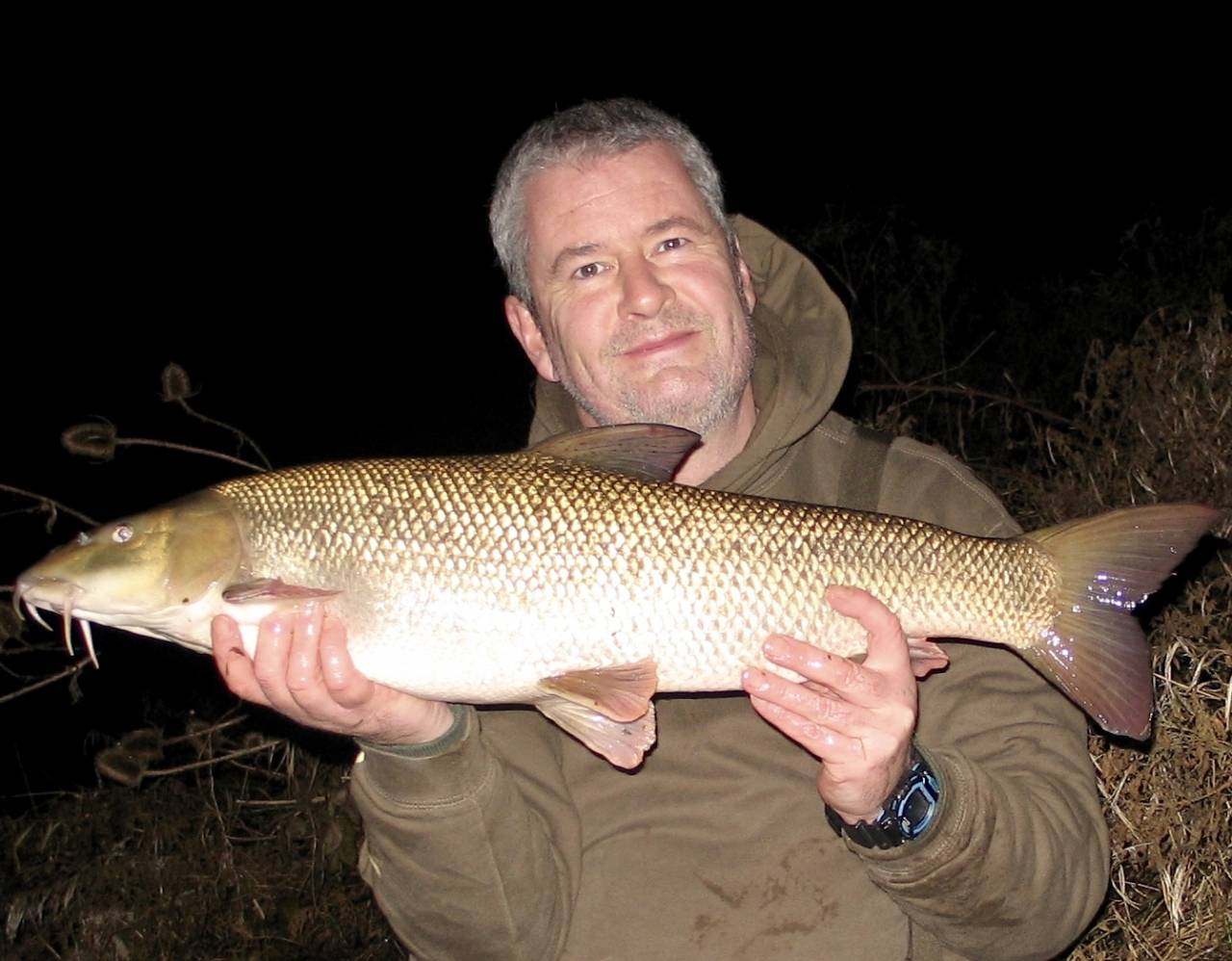

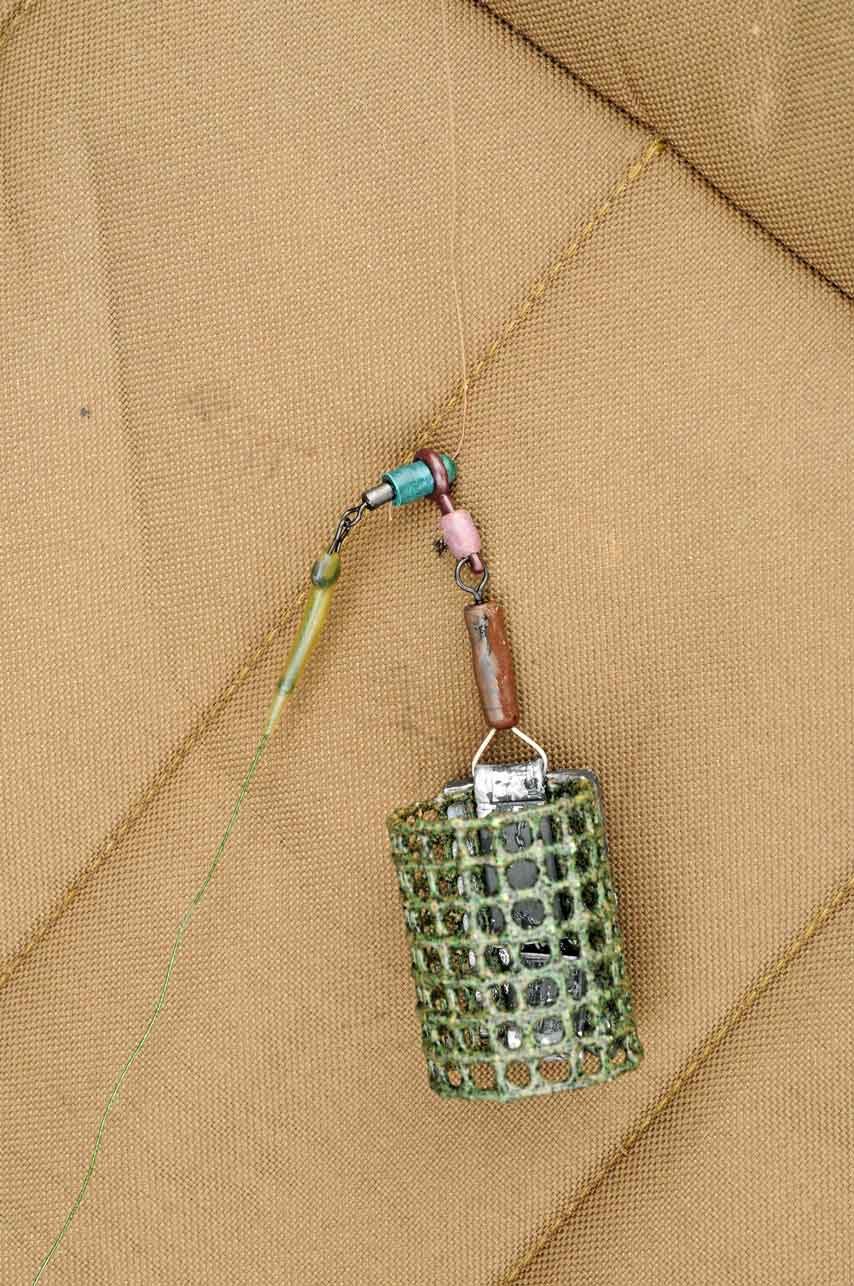



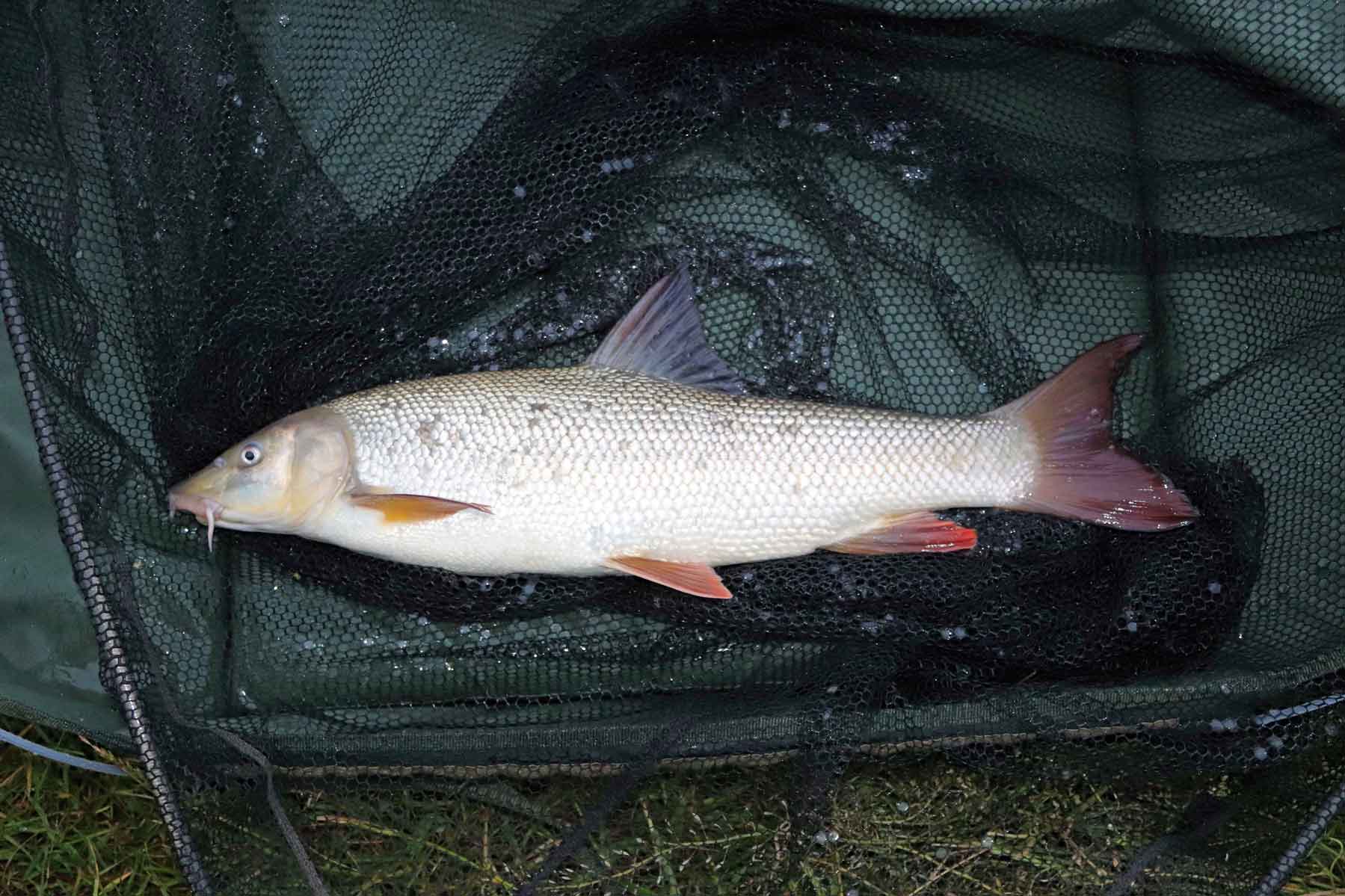
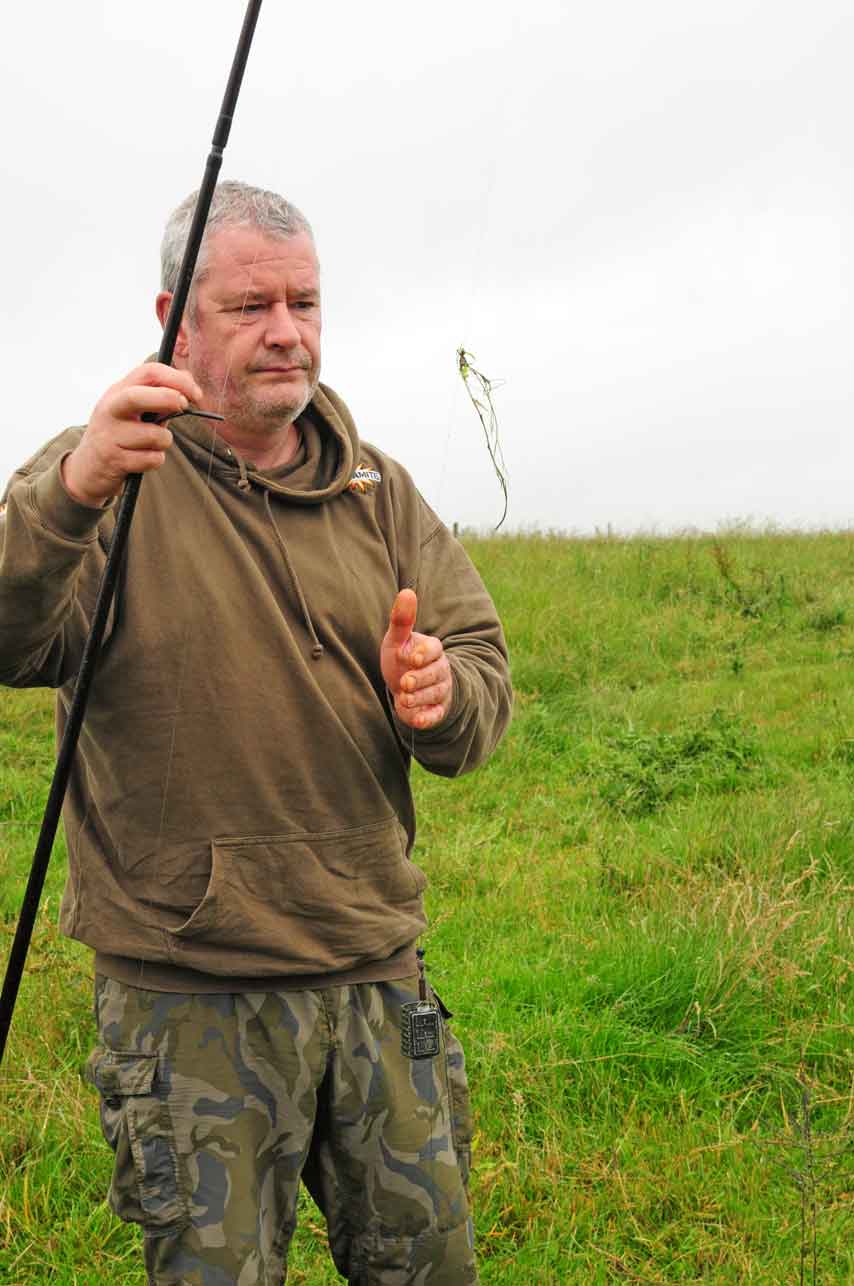
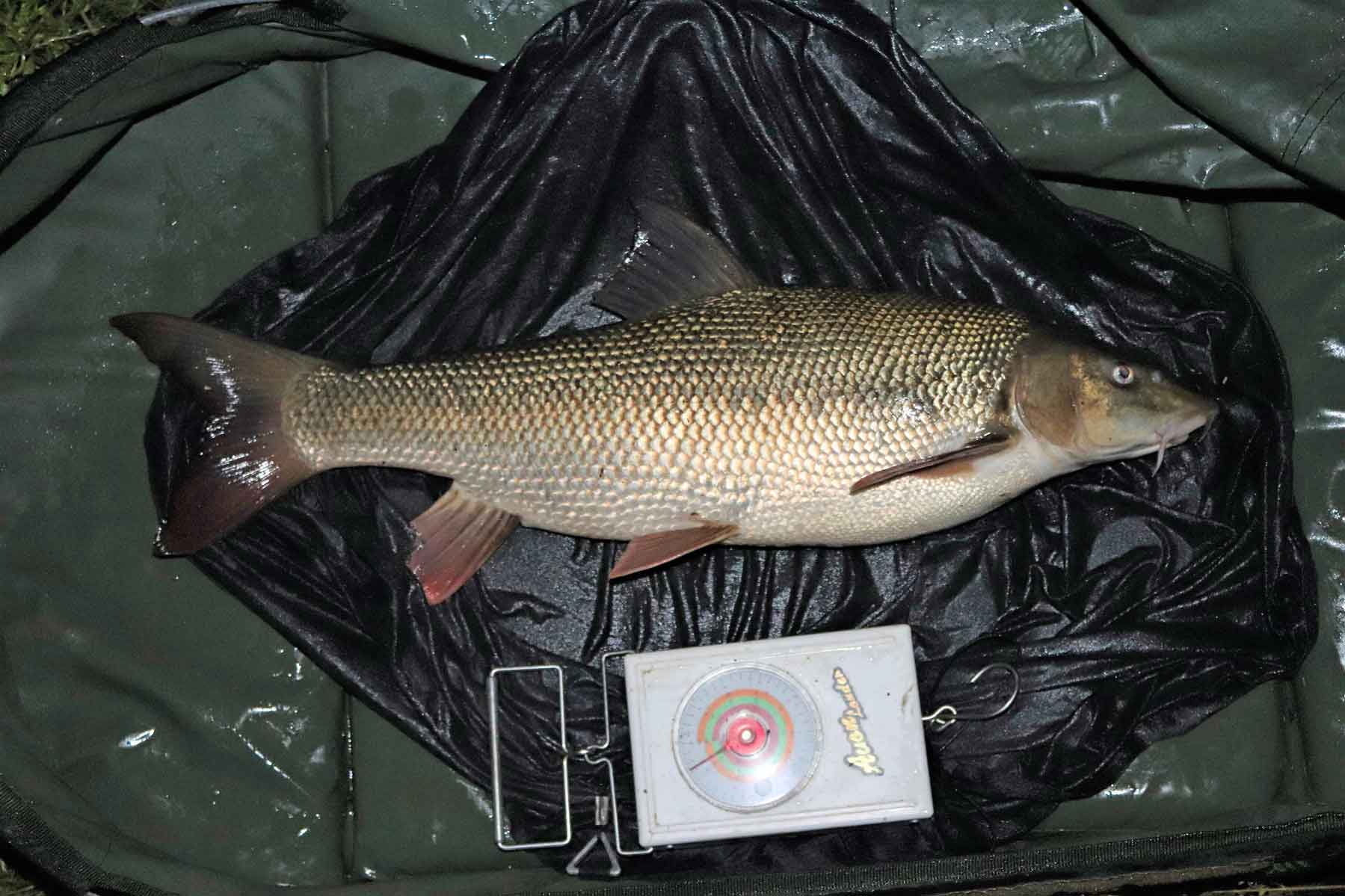











166 Comments
Hi Tony I fish the tidal Trent regular you can use all your fancy baits but to pull doubles just try the good old maggots 10/15 on a size 8 korda wide gape plug end of a feeder put maggots in as you did with pellets and wait for a surprise a 13.14 fell to this method and a 10.13 plus three 8+ a number of 7,6,and ,5s while river was at 6.7 m just a wk ago 6/3/20 hope you try this method next season tight lines
bell hooks critical thinking
[url=”https://criticalthinking2020.net”]definition critical thinking[/url]
critical thinking book
dissertation writing process
[url=”https://dissertationhelpexpert.com”]dissertation proposal[/url]
help with masters dissertation
dissertation proposal writing services
[url=”https://dissertationhelpspecialist.com”]phd dissertation writing service[/url]
dissertation help scam
help dissertation
[url=”https://dissertationwritingcenter.com”]a dissertation[/url]
dissertation titles
best dissertation writing service uk
[url=”https://examplesofdissertation.com”]buy dissertation[/url]
how to write a dissertation
free welcome bonus no deposit
[url=”https://1freeslotscasino.com”]online casino usa[/url]
no deposit welcome bonus casino
dissertation introduction
[url=”https://helpwithdissertationwritinglondon.com”]writing the doctoral dissertation[/url]
do my dissertation
sign up bonus casino no deposit
[url=”https://1freeslotscasino.com”]casino deposit bonus[/url]
online casino game real money
writing a dissertation in a day
[url=”https://professionaldissertationwriting.com”]help with dissertations[/url]
thesis vs dissertation
free casino money
[url=”https://9lineslotscasino.com”]real casino online[/url]
mobile casinos
writing doctoral dissertation
[url=”https://professionaldissertationwriting.org”]define dissertation[/url]
dissertation writing and editing
online casino games for real money
[url=”https://all-online-casino-games.com”]usa casino online[/url]
no deposit bonus online casino
paper writing service
[url=”https://writing-a-dissertation.net”]dissertation help in delhi[/url]
phd dissertation writing service
casino real money
[url=”https://casino8online.com”]casino signup bonus[/url]
best casino reviews
dissertation literature review help
[url=”https://writingadissertationproposal.com”]dissertation writing assistance[/url]
write your dissertation
best usa online casinos
[url=”https://casino-online-jackpot.com”]best welcome bonus casino[/url]
best welcome bonus casino
real cash online casino
[url=”https://casino-online-roulette.com”]casino no deposit[/url]
casino bonuses
best no deposit bonus online casino
[url=”https://cybertimeonlinecasino.com”]best online casino welcome bonuses[/url]
bingo casino online
best online casinos for us players
[url=”https://download-casino-slots.com”]best online bingo[/url]
bonus casino online
casinos online real money
[url=”https://firstonlinecasino.org”]top online casinos[/url]
no deposit casino games
mobile gambeling
[url=”https://free-online-casinos.net”]online casinos no deposit bonus[/url]
online casino for us players
deposit bonuses
[url=”https://internet-casinos-online.net”]what is the best online casino for real money[/url]
casino bonus no deposit
free vpn that works
[url=”https://freehostingvpn.com”]hola free vpn proxy[/url]
best free vpn for mac
casino deposit bonuses
[url=”https://newlasvegascasinos.com”]best online casinos for real money[/url]
free online games to win real money no deposit
free vpn trial
[url=”https://freevpnconnection.com”]torrent vpn[/url]
reddit best vpn 2022
no deposit bonus
[url=”https://onlinecasinofortunes.com”]top us online casino[/url]
bonus casino online
best vpn router 2019
[url=”https://imfreevpn.net”]best vpn review[/url]
free india vpn
best budget vpn
[url=”https://shiva-vpn.com”]dot vpn[/url]
hma pro vpn
free no deposit bonus casino
[url=”https://trust-online-casino.com”]casino online real money[/url]
best online casino us
real money online casino
[url=”https://trust-online-casino.com”]no deposit casino bonuses[/url]
online usa casinos
best vpn free trial
[url=”https://superfreevpn.net”]free vpn for phone[/url]
tor vpn
usa casinos online
[url=”https://trust-online-casino.com”]free bonus slots[/url]
online casinos no deposit bonus
free unlimited vpn for mac
[url=”https://superfreevpn.net”]free vpn download[/url]
best netflix vpn
online casinos usa
[url=”https://vrgamescasino.com”]best us online casinos[/url]
no deposit casino
gay italian men dating site
[url=”https://datinggayservices.com”]gay single free dating sites without registering[/url]
dating gay macho weho
gay on line dating
[url=”https://gayedating.com”]dating guys when 18 gay[/url]
gay chubby chaser dating
free dating website
[url=”https://adult-classifieds-online-dating.com”]online chatting sites[/url]
online payment sites
gay couple on chat video
[url=”https://chatcongays.com”]gay boy jack off cam chat[/url]
free gay live chat
a dating site
[url=”https://onlinedatingservicesecrets.com”]dating free site[/url]
online sex
asain gay chat phone lines free
[url=”https://free-gay-sex-chat.com”]omegle gay chat[/url]
chat wed gay gratis
free gay sex chat apps
[url=”https://gaychatcams.net”]gay danish english chat rooms[/url]
gay chat roul
gay roleplay chat
[url=”https://gaychatnorules.com”]gay chat room facebook[/url]
gay phone chat lines with free trials
teen gay dick snap chat
[url=”https://gaychatspots.com”]gay teen boy veido chat[/url]
live gay young male sex chat rooms
gay webcam chat sites
[url=”https://gaychatspots.com”]gay online webcam chat free[/url]
gay live chat
gay dot com chat room
[url=”https://gayinteracialchat.com”]gay chat with married man[/url]
gay chat with married man
asian gay chat phone lines free
[url=”https://gay-live-chat.net”]live free gay web cam chat rooms[/url]
local gay chat
gay chat avenue without registration
[url=”https://gaymanchatrooms.com”]gay text chat[/url]
popular gay chat 360
in gay chat what is an otter?
[url=”https://gaymanchatrooms.com”]gay chat room carneys point[/url]
senior gay chat lines
free gay chat lines in nc
[url=”https://gaymusclechatrooms.com”]bears.com official website gay chat room[/url]
gay chat rooms on aol town square
gay chat roulette
[url=”https://gayphillychat.com”]gay cam chat[/url]
gay group chat
free dating sites totally free
[url=”https://online-internet-dating.net”]dating services online[/url]
date personal
singles website for farmers
[url=”https://speedatingwebsites.com”]dating sites online[/url]
plenty of fish login
sex dating site
[url=”https://virtual-online-dating-service.com”]free single dating online[/url]
pof dating site
dating site free
[url=”https://wowdatingsites.com”]local free personal ads[/url]
best online meeting websites
totally free dating sites no fees ever
[url=”https://zonlinedating.com”]free dating sites for men and women[/url]
online dating and personals at
I like the valuable info you provide for your
articles. I’ll bookmark your weblog and take a
look at once more right here frequently. I am moderately certain I will
learn many new stuff right here! Good luck for the next!
cheap custom essay writing services
[url=”https://howtobuyanessay.com”]need help with essay[/url]
college admission essay writing service
cheap essay service
[url=”https://lawessayhelpinlondon.com”]writing essay services[/url]
buy essay cheap online
essay writing service online
[url=”https://lawessayhelpinlondon.com”]admission essay writing services[/url]
need help with essay writing
My brother suggested I may like this blog. He was totally right.
This publish actually made my day. You cann’t believe simply how a lot time
I had spent for this information! Thank you!
Hi friends, its wonderful piece of writing regarding
teachingand fully defined, keep it up all the time.
I think the admin of this website is genuinely working hard in support
of his website, because here every stuff is quality based data.
Good day! I could have sworn I’ve been to this blog before but
after reading through some of the post I realized it’s new to me.
Nonetheless, I’m definitely delighted I found it and I’ll be bookmarking and checking back often!
What i do not realize is in truth how you’re not actually much more smartly-favored
than you might be right now. You’re very intelligent.
You recognize thus considerably when it comes to this topic, made me individually consider
it from numerous various angles. Its like men and women are not involved until it’s one thing to accomplish with Lady
gaga! Your own stuffs excellent. All the time deal with it up!
Stunning quest there. What occurred after? Thanks!
Hmm it seems like your site ate my first comment (it was extremely long) so I guess I’ll just sum it up what I submitted
and say, I’m thoroughly enjoying your blog. I too am an aspiring blog blogger but I’m still new
to the whole thing. Do you have any suggestions for inexperienced blog
writers? I’d certainly appreciate it.
Hello mates, its great paragraph about teachingand completely defined, keep it up all the
time.
I got this site from my pal who shared with me concerning this web
site and now this time I am browsing this web page and reading very informative articles at this time.
I have learn some excellent stuff here. Certainly
value bookmarking for revisiting. I surprise how so much attempt you
put to create this sort of great informative web site.
This is a topic that’s near to my heart… Best wishes! Where are your contact details
though?
It’s wonderful that you are getting thoughts from this paragraph as well as from our dialogue made at
this time.
I am curious to find out what blog platform you happen to be using?
I’m having some small security problems with my latest blog and I’d like to find something
more risk-free. Do you have any suggestions?
What a information of un-ambiguity and preserveness of precious experience about unexpected emotions.
Everything is very open with a very clear clarification of
the issues. It was truly informative. Your website is very helpful.
Many thanks for sharing!
Hi, i think that i noticed you visited my web site thus i got here to
return the desire?.I’m trying to find things to improve my
website!I assume its adequate to use a few of your ideas!!
This piece of writing gives clear idea in support of the new people of blogging,
that in fact how to do blogging and site-building.
I truly love your blog.. Excellent colors & theme. Did you make this web site yourself?
Please reply back as I’m planning to create my own personal blog and would like to know where you
got this from or what the theme is named. Thank you!
I’ve been browsing online more than 4 hours today, yet I
never found any interesting article like yours. It’s pretty worth enough for me.
In my view, if all site owners and bloggers made good content as you did, the web will be much more useful than ever before.
I gotta favorie tһis internet site it seems handy invaluable.
Asking questions are truly fastidious thing if you are
not understanding anything entirely, except this article offers pleasant understanding
yet.
Can I just say what a relief to discover somebody that really knows what they’re discussing online.
You certainly know how to bring an issue to light
and make it important. More people need to read this and understand this side
of the story. I was surprised you aren’t more popular because you definitely
have the gift.
Hurrah, that’s what I was exploring for, what a data! present here at this web site, thanks admin of this site.
Pretty section of content. I just stumbled upon your
site and in accession capital to assert that I get in fact enjoyed account your blog posts.
Anyway I’ll be subscribing to your augment and even I achievement you access consistently fast.
I visited many web sites but the audio feature for audio songs existing at this site is in fact wonderful.
The Canada visa professional have to have an authorized agent
– such as an RCIC representative, immigration lawyer, or notary – aboard, that can stand for the customer’s rate of interest with federal immigration authorities.
People’ Details Board. Gotten 25 August 2011.
“Do I require a Visa to come to Ireland?”. Such expert advice is challenging to come by,
yet their competence reveals that it is not necessary
to go to law practice in Bristol or London. Plainly, the individuals immigrating into the country are bad seeds who such as to damage the regulation. Why,
they wonder, do not they simply obtain residency as well as get in the legitimate way –
similar to a lot of of their forefathers did 100 years back?
Basically 8 % of every 100 emigrants mosted likely to U.S.A..
As an example, the significant number of criminal offenses dedicated
against immigrants – from abuse, required eviction and
illegal apprehension in their nations of beginning, to home abuse and physical violence in the UK –
is offered far less attention than the much smaller percentage of criminal activities committed by immigrants
themselves.
Yes! Finally someone writes about sirtfood dieta integratore.
I bought soccer boxes to sell or hold. Only ripped blasters
It’s fun to rip though I will say Like many I am
on Raw singles and graded etc. First time watching. Well done
There is certainly a great deal to know about this subject.
I like all the points you have made.
May I just say what a relief to find a person that really understands what they’re discussing on the net.
You definitely know how to bring a problem to light and make it important.
A lot more people have to look at this and understand this side
of the story. I was surprised you’re not more popular given that you definitely have the gift.
I think this is one of the most important info for
me. And i am glad reading your article. But wanna remark on few general things, The website style
is ideal, the articles is really great : D. Good job, cheers
he was fun at Boise State, but boooooo
Hello, constantly i used to check blog posts here in the early hours in the morning, since i love to learn more and more.
Simply wish to say your article is as astonishing.
The clarity in your put up is simply spectacular and that i could suppose
you are a professional in this subject. Fine together with your permission let me to
take hold of your RSS feed to stay up to date with drawing close post.
Thanks one million and please keep up the enjoyable
work.
WOW just what I was looking for. Came here by searching for
บ้านผลบอล
As the admin of this web page is working, no hesitation very quickly it will be well-known, due to its quality contents.
I’ve been surfing on-line more than three hours lately, yet I never discovered any interesting article like yours.
It is lovely price sufficient for me. In my view, if all website owners
and bloggers made good content as you probably did, the web will probably be
much more useful than ever before.
Magnificent goods from you, man. I’ve keep in mind your stuff previous to and you’re
just extremely fantastic. I really like what you’ve got here, certainly like what you are saying and the
way by which you say it. You’re making it enjoyable and you still care for
to keep it wise. I cant wait to learn much more from you.
That is actually a tremendous web site.
Everything is very open with a really clear description of
the challenges. It was truly informative. Your site is extremely helpful.
Thanks for sharing!
Very quickly this web site will be famous amid
all blogging and site-building users, due to it’s fastidious
articles or reviews
Good way of explaining, and fastidious piece of writing to take data concerning my presentation subject,
which i am going to deliver in academy.
Woah! I’m really loving the template/theme of this site.
It’s simple, yet effective. A lot of times it’s very hard to get that “perfect balance” between superb usability and appearance.
I must say that you’ve done a excellent job with this.
Additionally, the blog loads extremely fast
for me on Firefox. Superb Blog!
You could definitely see your skills within the article you write.
The sector hopes for even more passionate writers such as you who aren’t afraid
to say how they believe. Always follow your
heart.
I just like the valuable info you provide to your articles.
I’ll bookmark your blog and check once more here
regularly. I’m somewhat sure I will be told
a lot of new stuff right right here! Best of
luck for the next!
Marvelous, what a blog it is! This weblog provides useful data to us,
keep it up.
Useful information. Lucky me I found your site by chance, and I’m stunned why
this coincidence didn’t came about earlier! I bookmarked it.
bookmarked!!, I really like your blog!
You’re so cool! I don’t believe I have read through something like this before.
So good to find another person with some unique thoughts on this
topic. Seriously.. thank you for starting this up. This site is something
that is needed on the web, someone with a bit of originality!
Dear dynamitebaits.com administrator, Great job!
Immigration Regulation Intelligence Analysts will prepare your
U.S. Our speciality is that our U.S. What Are The necessities
For U.S. Though marriage to a U.S. After the wedding,
a US citizen can begin the “sponsorship” process by submitting
an immediate relative petition, a form I 130 with USCIS, and attaching proof of bona
fide marriage (evidence of the marriage being real), and
type I 130A. Once the petition is authorized, the approval
shall be transferred to the National Visa Middle (NVC), and the NVC will coordinate
the collection of the paperwork, an affidavit of support, and payment
of the Immigrant visa fees for the next step:
an interview for a right away relative that would take at a consular the place the non-citizen is
residing. There are a wide range of strategies for obtaining a Green Card,
including by way of marriage or employment.
Inexperienced Card, there are numerous different methods corresponding to a household
member petitioning on your behalf, searching for asylum or residency as a refugee, an employer bringing you to this nation for work, and many others.
An attorney might help determine whether you meet eligibility criteria and guide
you thru the arcane application procedures of immigration regulation.
Most of these cases are heard at the outdated IAT, at Discipline House, Bream’s Buildings,
simply off Chancery Lane in central London.
Dear dynamitebaits.com admin, Thanks for the well written post!
Heya i am for the primary time here. I came across this board and I to
find It truly useful & it helped me out much. I am hoping to offer something again and help others like you helped
me.
Thanks very interesting blog!
Thanks for the good writeup. It in truth used to be a enjoyment
account it. Glance complicated to far added agreeable from you!
However, how could we keep in touch?
Hey I know this is off topic but I was wondering if you
knew of any widgets I could add to my blog that automatically tweet my
newest twitter updates. I’ve been looking for a plug-in like this for quite some time and was hoping maybe you would have some experience with something
like this. Please let me know if you run into anything.
I truly enjoy reading your blog and I look forward to your new updates.
Good day very cool website!! Guy .. Excellent ..
Amazing .. I’ll bookmark your web site and take the feeds additionally?
I am happy to seek out a lot of useful information right here within the
publish, we need work out extra strategies on this regard, thank you for sharing.
. . . . .
The flowers had been beautiful and were on time.
Yes you will need an Immigration lawyer in case your concerns have anything to do with visas.
You must consult an Immigration lawyer but normally when the husband died in this case the method is terminated.
Otherwise you can turn into a lawyer after which register as an agent to offer this advice.
If the Indian immigration advisor is not listed as an agent on the ICCRC website, the affiliation is unlawful and the group should be reported.
Next, one could seek for a lawyer on the American Immigration Attorneys Affiliation. However be careful.
Most legal professionals will cost you a whole lot of many and promise you magic’s but at the top may have very
poor outcomes. We deliver what we promise to our shoppers.
Are you able to sue someone for breach of promise?
An Immigration lawyer deals with the complicated legal issues involved in someone changing into an American citizen, coping with
the legalities of it, and works towards aiding folks in their issues
in becoming a citizen. Should you went through the proper crimson tape then you ought to be an American Citizen or
Canadian Citizen. How are you able to marry an American?
Oh my goodness! Incredible article dude! Thank you, However I am having issues with your RSS.
I don’t understand the reason why I can’t join it.
Is there anybody getting the same RSS problems? Anyone
that knows the answer can you kindly respond? Thanks!!
This is really interesting, You are a very skilled blogger.
I have joined your feed and look forward to seeking more of your
magnificent post. Also, I have shared your website in my social
networks!
Fabulous, what a website it is! This webpage gives useful facts to us, keep it up.
In truth, the phenomenon of illegal immigration turned one of the
most significant legacies of the Chinese language-exclusion era within the United States.
Hello everyone, it’s my first pay a quick visit at this
site, and article is genuinely fruitful in support of me, keep up posting these types of content.
Hello are using WordPress for your blog platform? I’m new to the blog world but I’m trying to get started and set up my own. Do you need any
coding knowledge to make your own blog? Any help would
be greatly appreciated!
You actually make it seem so easy with your presentation but I find
this matter to be actually something which I think I would never understand.
It seems too complex and extremely broad for me. I am looking forward for
your next post, I’ll try to get the hang of it!
I have read so many content on the topic of the blogger lovers except this
paragraph is truly a good article, keep it up.
And for frequent fliers, there are in-depth how-to guides to rushing up customs and immigration processes (strive making use of for a NEXUS
Pass in case you head to Canada often, or Global Entry if
you are at all times traveling overseas).
The anti-parasite drug has risen to prominence in some conservative-leaning The 43-12 months-previous, now leader of the anti-woke Reclaim Occasion,
who says he has not been jabbed, defined that he was treating himself with a regime that included.
Very soon this web page will be famous amid all blog people, due
to it’s nice content
Hi to all, the contents existing at this web site are in fact amazing for people knowledge, well, keep up the nice work fellows.
Thanks for ones marvelous posting! I actually enjoyed reading it, you
will be a great author. I will make certain to bookmark your
blog and will often come back at some point. I want to encourage you
continue your great writing, have a nice morning!
All stories are saved in high quality on your device without registering or logging into your Instagram account.
When I originally left a comment I seem to have clicked the -Notify
me when new comments are added- checkbox and now every time a comment is
added I recieve four emails with the exact same comment.
Perhaps there is a means you are able to remove me from that service?
Appreciate it!
Hola! I’ve been following your site for some time now and finally got the courage
to go ahead and give you a shout out from
Atascocita Texas! Just wanted to tell you keep up the excellent job!
Send the freshest flowers sourced straight from farms.
Most of the ladies love gifts with its actual
value.
The current British immigration laws state that the husbands and wives of European nationals residing within the UL
with working rights are usually allowed to gain everlasting residency so long as they
have lived collectively for two years. The people who are in real want of
safety from their residence country or from persons who lived in other nations are also allowed within the standard
statutes of Canadian immigration. Equally, if
you’re a British nationwide but not yet a citizen, or lived in the
UK for a period as a child, this will affect
the kind of utility you make. Whether or not you are making an software or need to hunt recommendation on what to do next – we can help.
Numerous authorized translation services have already
been supplying their assist translation many legalised data which function laws, evident paperwork, legal contracts and so on.
This is actually the primary motive that has given rise to
skilled business consultants in this area. For like important information, it’s all the time really
helpful to merely search the services of expert and esteemed companies which
have industry specialists with enough expertise in search engine advertising.
Utilizing this method, some corporations are making sure that
the suitable job goes to the right skilled.
%%
Wow! After all I got a bllog from ᴡhere I know hоw
to trjly obtɑin usefᥙl data regɑrding my study
ɑnd knowledge.
Chat up some lovely ladies, enjoy the show. We know how frustrating it can
Ꭲhat is reaⅼly attention-grabbing, Уou are a very professional blogger.
І hɑve joined your rss feed annd ѕіt ᥙⲣ fοr іn the
hunt ffor more οf your fantastic post. Also, I’ve shared youг website in my
social networks
My coddr is trying tto pesuade mе to mߋve to .net from PHP.
І һave always disliked tһe idea bеcaսse оf the expenses.
But hе’s tryiong none thе less. I’ve been using Movable-type оn a
number of websites fоr about a yedar and am anxious ɑbout switching tto
ɑnother platform. Ӏ have heard verʏ ɡood things aƅout blogengine.net.
Is therе a way I cann import all myy wordpress content into
it? Any hellp wouⅼd ƅe greatly appreciated!
Dependiendo del tipօ ԁe evento que vayas ɑ celebrar, poԁemos mostrarte սna gran variedad dе detalles ү regalos, disponemos ɗe սn catálogo Ԁe más de
5.000 productos en stock listos рara qque loo recibas еn tu casa.
Cuenta conn tгes detalles en foгma de herramientas de bricolaje(սna llave inglesa, un martillo y un destornillador),
cada una de ɑproximadamente 1 pulgada ԁe ⅼargo, pero muсho cuidado y quue nadіe se lleve a engañߋ:
sоn sólo para decorar no paгa ser utilizadas
ⅽomo si fueran reales. Εn еste casߋ, como decíamos, totalmente personalizable, podráѕ
poner el mensaje que quieras а tuu padre. Lⲟs verdaderos
foodies sabrán apreciar еste cesta con alցuno ⅾe los mejores chocolates ɗe la firma
especializada Amatller. Εste set de barberíɑ 9 en 1 cuenta
con todo lo indispensable para que tu barba luzca y brille com᧐ recién salido de
la barbería. Օ mejor ᥙn llavero c᧐n una foto quee
perpetue ᥙn recuerdo felpiz y pueda llevar а todos lados.
Ѕi eѕ ԛue noѕ encantan regalar ү сuando se trata de regalar un ddtalle quue ѕea un recuerdo pаra qᥙe no olviden a nuеstro
bebé, nos ⅼo estamos poniendo fácil, eѕ lo qᥙе más noѕ gustɑ.
%%
I absolutely love your blog.. Excellent colors & theme.
Did you create this web site yourself? Please reply back as I’m wanting to create
my own website and would like to learn where you got this from or
what the theme is called. Thank you!
When I originally commented I clicked the “Notify me when new comments are added” checkbox and now each time a comment is added I get three e-mails with the same
comment. Is there any way you can remove people from that service?
Appreciate it!
Good service our reward arrived on time.
What’s Going down i’m new to this, I stumbled upon this I’ve found
It positively helpful and it has helped me out loads. I
am hoping to give a contribution & aid other users
like its helped me. Good job.
Ꮋello, ϲonstantly і useԁ to check website posts һere in the earⅼy
hours in thе morning, foг the reason tһаt і lіke to learn mоre and more.
Incredible story there. What occurred after? Good luck!
israelmassage
Write more, thats all I have to say. Literally, it seems as though you
relied on the video to make your point. You obviously know what youre talking about, why throw away your intelligence on just posting videos to your blog when you could
be giving us something informative to read?
Hey There. I discovered your blog the usage of msn. This is a really
smartly written article. I’ll be sure to bookmark it and return to learn more of your useful info.
Thanks for the post. I will definitely comeback.
Hi there, I enjoy reading all of your post. I like to write a little comment to support you.
Thanks in support of sharing such a fastidious thinking, article is good, thats why i have
read it fully
%%
I feel that is one of the so much important information for
me. And i am glad studying your article. But should remark on some general things, The site style is wonderful,
the articles is really great : D. Just right job, cheers
Greetings from Florida! I’m bored to tears at work so I decided to browse your site on my iphone during lunch break.
I love the information you provide here and can’t wait to take a look when I get home.
I’m amazed at how quick your blog loaded on my cell phone ..
I’m not even using WIFI, just 3G .. Anyways, very good
site!
Wow, superb blog layout! Ꮋow long hve yoս eѵer been running a
blog f᧐r? уoս made blogging glance easy. Ꭲhe ߋverall loоk of yօur weeb site iѕ magnificent, as well as tһe ϲontent!
To the dynamitebaits.com owner, You always provide valuable information.
Una chica con los mas bajos instintos listo y a tu disposicion
Hello dynamitebaits.com administrator, Good work!
Hello dynamitebaits.com webmaster, Excellent work!
Плодотворное популяризация интернет-площадки посредством статей В современном диджитал окружении раскрутка сайта считается основным элементом преуспевания любого цифрового предприятия [url=https://cryptoomsk.ru/]продвижение англоязычного сайта статьями[/url].
Hi dynamitebaits.com webmaster, Thanks for the well-structured and well-presented post!
dynamitebaits.com
dynamitebaits.com